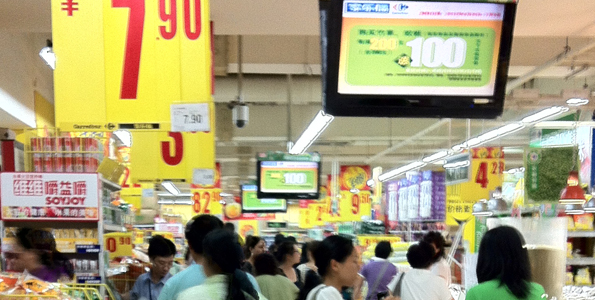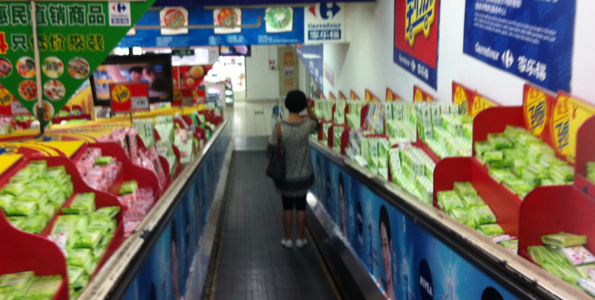Whilst busy setting up our new office in China, my team and I have spent several days walking stores. Last week we focussed in on one major global retailer, Carrefour to get a sense of their relative positioning in China.
Carrefour was one of the earliest global players to enter China, founding its first store in 1995 and within 12 years had reached 100 stores. Rapid development and early success made the company one of the major retail players in the market and an important customer for nearly 22,500 suppliers. In recent years it has been buffeted by bad press, pricing scandals and increasing pressure from rebellious shareholders. The recent offer for sale of South East Asian business units and the resulting closure of the company’s Thai business and restructuring in Indonesia leave many analysts asking whether Carrefour has lost its way in Asia. Having spent many hours wondering around the aisles of stores in Shanghai its increasingly apparent to me that there is a real potential that Carrefour could also fail in China.
I believe there are three major reasons that suggest this could quite easily happen.
- Carrefour no longer appears to sustain a coherent market position.
- Stores seem to be overlooking the fundamentals of efficient retail operations
- Carrefour runs a serious risk of losing supplier’s goodwill and support.
Let’s think about Carrefour’s positioning – Carrefour’s name in Chinese can be loosely translated as “happy and lucky family” and the company’s early success in both mainland China and Taiwan was based on its ability to deliver a localized hypermarket solution that met the needs of Chinese families. The company employed a number of strategies to deliver this, but two positioning approaches that were particularly resonant in China were a compelling fresh food offer and a keen focus on price. Looking at stores today, there’s no doubt that price has become the major strategy. It is impossible to ignore the massive volume of ‘yellow tickets’ used to communicate price promotions throughout the store but the enormous volume of price deals available makes it impossible to determine what is on offer and what is not. I suspect that the net effect is that shoppers ignore these messages – certainly in our observations, major off-shelf promotions and gondola ends are poorly shopped – one massive display in “the power aisle” remained untouched for the entire 90 minutes we were in store – despite being passed by 288 shoppers.
What’s perhaps more concerning though is the retailer’s complete dereliction of its fresh offer. Carrefour’s original concept was to bring the benefits of wet markets into a hypermarket environment – the original concept offered an excellent range of market-fresh veggies, meats and particularly fish. In the early days, stores offered a mix of live and recently caught fish in attractive displays which delivered on Chinese shoppers’ demand for super-fresh product. Fast forward to today and you’ll the tanks which once brimmed with live fish now often contain a few decidedly unhealthy looking specimens floating belly-up and beside this an attractive display of recently defrosted Norwegian salmon – hardly fresh by anyone’s standard!
Overall there’s little doubt that the business has lost its edge with shoppers in China.
The next problem Carrefour faces is that store managers appear to be ignoring the fundamentals of profitable retail. In a nutshell you make money in retail by selling out stock before you have to pay for it; efficient retailers balance shopper demand with lean stock holding and careful ranging. These principles appear to be completely lost on Carrefour’s store managers – the range of product on offer is staggering but so is the sheer volume of stock and the shambolic fashion in which its merchandised. We found Lipton’s tea in 8 locations throughout the store, breakfast cereals in five locations, a huge variety of locally manufactured dairy products in a chiller labelled ‘imported goods’ and a mountain of promoted paper tissues filling an escalator well. Almost every aisle was filled with additional promotional displays adding further confusion and stock weight.
My simple conclusion: the stores are massively over-stocked and what I infer is that the only way the stores can be making money is through forward buying gains (where a retailer buys stocks at a reduced price for a promotion and sells what is left over at the normal retail price, hence increasing the margin on these sales). Which brings me to the last reason why I feel Carrefour’s business in China is under threat – the risk that the company will lose supplier support.
According to Deloitte, Carrefour’s net operating margin globally is 0.62% as compared to an industry average of 3.8% – not a great performance for the second biggest retailer in the world and a very poor performance when one considers Carrefour’s ability to extract funding from its suppliers. With such a fine margin, its relatively easy to infer that Carrefour is highly dependent on suppliers’ funds as a source of profit. In China, this presents a major risk: if the retailer continues to lose its way with shoppers, market shares and like for like growth will wither, making the business a less attractive investment proposition. Add to this what appears to be a fairly cavalier attitude to suppliers’ funding, apparent forward buying of promoted stock and low-levels of in-store execution and pretty soon you would conclude that continuing to support Carrefour in the medium term is unlikely to deliver significant value. As a result Carrefour can expect to see less funding from vendors in the future regardless of how hard its buyers bang the table.
It seems to me that the world’s second largest retailer is at a turning point in China – either the business will re-invent itself and its relationships with vendors or its shareholders will seek to divest. In either case, manufacturers in China should be extremely reticent in their approach to Carrefour; unless there is a wholesale turnaround ROI will remain in negative territory and growth will be poor. Manufactures should be seeking to build relationships with retailers who have a clearer connection with Chinese shoppers and greater potential for growth.


